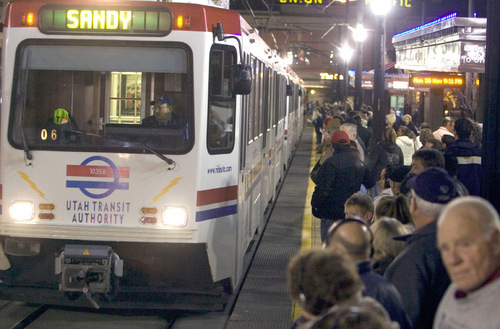This is an archived article that was published on sltrib.com in 2011, and information in the article may be outdated. It is provided only for personal research purposes and may not be reprinted.
The Utah Transit Authority board on Wednesday unanimously approved raising its basic fares by 25 percent over the next two years. It also signaled that after that, it plans to start basing fares on distance traveled rather than the current flat-rate charge for trips of any length.
UTA's current regular bus and TRAX adult fares are $2.25 per trip (a base of $2 plus a temporary 25-cent fuel surcharge). UTA will now increase its base fare for adults in increments to $2.50 by April 1, 2013.
Riders won't notice a difference when the first part of the increase kicks in on May 1. Fares then will be $2.25 — the same as is charged now — except that the temporary 25-cent fuel surcharge disappears and the base fee rises to $2.25.
UTA would then hike standard fees again on April 1, 2012, to $2.35, and to $2.50 on April 1, 2013.
As part of the new fare schedule, UTA reworked its fuel surcharge rules. Until now, if diesel prices averaged more than $3 a gallon in a three-month period, UTA temporarily hiked fares by 25 cents during the following three months — and lowered them back whenever prices again averaged below $3 a gallon.
Under the new schedule, fuel surcharges will be triggered when diesel reaches $4 a gallon. An extra 25 cents per trip would be charged when diesel is between $4 and $4.99 a gallon; 50 cents if it is between $5 and $5.99; and 75 cents if it is between $6 and $6.99; and so on.
The new fare hike is estimated to generate $1 million to $1.4 million in extra revenue this year, and an extra $10 million to $12.3 million over three years.
UTA General Manager Michael Allegra also told the board that after the currently ordered fare increases through 2013, UTA hopes to move to a system that will charge higher fares for greater distances traveled instead of flat rates for all trips.
He said the agency has been implementing electronic payment systems that would allow such a system, including "tap on, tap off" electronic cards that riders touch at the beginning and end of trips to have their fares automatically deducted from the card.
Allegra said UTA also has been installing GPS satellite equipment to more accurately identify locations of bus stops and distances traveled between them. At the same time, the agency has been evaluating the cost per mile of various services, and determining what the market may be willing to pay.
A recent analysis by The Salt Lake Tribune shows that the UTA already had among the highest bus and train fares in the nation before the new fare hike.
Its current total fare of $2.25 was tied for fifth-highest among 193 transit systems nationally that responded to an American Public Transportation Association survey completed last August.
The average base fare charged by other systems nationally is $1.50. UTA's current fare is 50 percent higher, and the now-approved fare hike to $2.50 in 2013 would make UTA's 66 percent higher than the average.
Some of those systems are far different in size than UTA. Of the 10 systems that APTA said are most similar to UTA (based on trips taken and passenger miles traveled), the average bus fare is $1.79.
UTA reported receiving little vocal opposition to the fare increase. It said it had received only 87 comments from the public about the proposal through its website, phone calls and public hearings, and 75 were against it. (Three people also protested hikes for paratransit service at the UTA's meeting on Wednesday.)
UTA held seven public hearings in six counties on the rate increase, but only 21 people gave comments at them.
UTA also is proposing changes to raise many fares besides just the base, single-trip rate for adults. For example, paratransit fees for the disabled would rise from a base of $2.50 a trip to $4 in 2013, a 60 percent increase.
Other increases include raising the cost of an adult monthly pass from a base of $67 to $83.75 in 2013, up 25 percent. Also proposed is hiking the discount, single-trip fares for seniors and students from a base of $1 to $1.25 in 2013, also up 25 percent. —
UTA fares among highest in nation
Even before the increase kicks in, the Utah Transit Authority has among the priciest bus and train fares in the nation. The current fare of $2.25 (including a 25-cent fuel surcharge) is tied as the fifth-highest among 193 transit systems nationally. The average base fare charged nationally is $1.50.
Source: American Public Transportation Association, Tribune analysis





